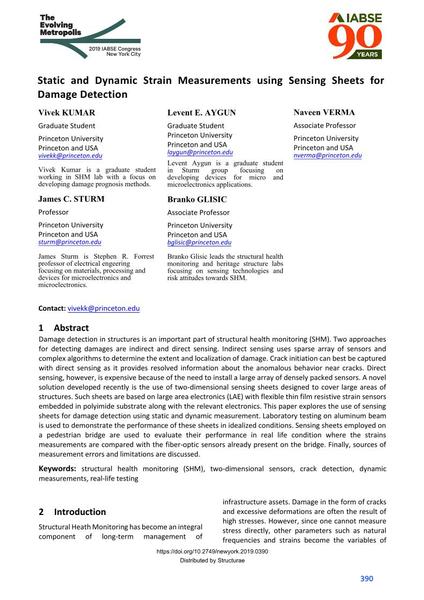Static and Dynamic Strain Measurements using Sensing Sheets for Damage Detection

|
|
|||||||||||
Bibliografische Angaben
| Autor(en): |
Vivek Kumar
(Princeton University)
Levent E. Aygun (Princeton University) Naveen Verma (Princeton University) James C. Sturm (Princeton University) Branko Glisic (Princeton University) |
||||
|---|---|---|---|---|---|
| Medium: | Tagungsbeitrag | ||||
| Sprache(n): | Englisch | ||||
| Tagung: | IABSE Congress: The Evolving Metropolis, New York, NY, USA, 4-6 September 2019 | ||||
| Veröffentlicht in: | The Evolving Metropolis | ||||
|
|||||
| Seite(n): | 390-396 | ||||
| Anzahl der Seiten (im PDF): | 7 | ||||
| DOI: | 10.2749/newyork.2019.0390 | ||||
| Abstrakt: |
Damage detection in structures is an important part of structural health monitoring (SHM). Two approaches for detecting damages are indirect and direct sensing. Indirect sensing uses sparse array of sensors and complex algorithms to determine the extent and localization of damage. Crack initiation can best be captured with direct sensing as it provides resolved information about the anomalous behavior near cracks. Direct sensing, however, is expensive because of the need to install a large array of densely packed sensors. A novel solution developed recently is the use of two-dimensional sensing sheets designed to cover large areas of structures. Such sheets are based on large area electronics (LAE) with flexible thin film resistive strain sensors embedded in polyimide substrate along with the relevant electronics. This paper explores the use of sensing sheets for damage detection using static and dynamic measurement. Laboratory testing on aluminum beam is used to demonstrate the performance of these sheets in idealized conditions. Sensing sheets employed on a pedestrian bridge are used to evaluate their performance in real life condition where the strains measurements are compared with the fiber-optic sensors already present on the bridge. Finally, sources of measurement errors and limitations are discussed. |
||||
| Stichwörter: |
Risserkennung dynamische Messungen
|
||||
